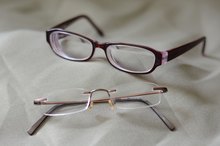Side Effects of Progressive Lenses
Many people in their 40s start having problems reading, and they may need multifocal lenses to improve reading vision. Trifocals offer a top for distance, a middle section for the distance of a dashboard and a bottom portion for reading up close. The lines between each prescription may disrupt vision for some. If that's the case, no-line progressive lenses offer many benefits, though a person should know the side effects of these lenses, both good and bad, before ordering 123.
Adjustment Period
Many people have a difficult time adjusting to progressive lenses 12. If looking in the distance, a person must always point her nose in the direction she looks to make sure she looks through the proper section of the progressive lens. Failing to do this, some people find that distance vision appears blurry. However, even though people new to progressive lenses must change the way they move their heads, over time the movement feels natural, and they will not have to think about how to use the lenses 23. Anyone who feels they cannot adjust to the lenses should return to his or her doctor’s office to discuss the problems, is the advice given by experts at Master Eye Associates 1.
Frames
Problems With Multifocal Contact Lenses
Learn More
Progressive lenses fit in most eyeglass frames 123. An optician, the person who fits the eyeglasses at the doctor’s office, will help ensure that the frames a person chooses will work well with a progressive lens. However, a person should make sure that the frames she chooses will fit her face well and feel comfortable. When the new frames and progressive lenses return from the laboratory, the patient must have them adjusted 2. If the frames do not fit properly, with pupils looking directly through the center of the lens, the person may have blurry vision.
Vision
Good vision is a positive side effect of progressive lenses 23. People who use reading glasses only have to take the glasses off when they look up or away from their reading material. A bifocal lens has a line, but gives a top section for distance vision and a bottom section for reading. However, middle distance, such as a computer screen, may appear out of focus. Progressive lenses will give all three distances, without a line to interfere with the quality of vision 23.
Related Articles
References
- Master Eye Associates: Progressive Lenses: No-Line Bifocals
- All About Vision: Progressive Lenses Come of Age
- Alvarez TL, Kim EH, Granger-donetti B. Adaptation to Progressive Additive Lenses: Potential Factors to Consider. Sci Rep. 2017;7(1):2529. doi:10.1038/s41598-017-02851-5
- Han SC, Graham AD, Lin MC. Clinical assessment of a customized free-form progressive add lens spectacle. Optom Vis Sci. 2011;88(2):234-43. doi:10.1097/OPX.0b013e31820846ac
Writer Bio
Kate Beck started writing for online publications in 2005. She worked as a certified ophthalmic technician for 10 years before returning to school to earn a Masters of Fine Arts degree in writing. Beck is currently putting the finishing touches on a novel.








